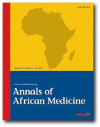
|
Annals of African Medicine
Annals of African Medicine Society
ISSN: 1596-3519
Vol. 2, Num. 2, 2003, pp. 101-102
|
Annals of African Medicine, Vol. 2, No. 2, 2004, pp. 101-102
Letter to the Editor
DIPYRONE (NOVALGIN, METAMIZOLE): BANNED AND UNBANNED: THE
DILEMMA OF A COMMONLY PRESCRIBED AND OVER
THE COUNTER ANALGESIC
Bello Shuaib
Oricha and Muhammad Bala Yauri
Department of Pharmacology
and Toxicology, College of Health Sciences, Usmanu Danfodiyo University, Sokoto,
Nigeria
Code Number: am03023
Dear
Editor,
Pain Management has recently and
increasingly acquired importance as a clinical
field of its own right. 1 This has been followed by an increasing
number of new generation analgesics targeted against better defined pain pathways
and modulators. 2 However in developing countries, such new analgesics
are often not available and may not be cost effective. Dipyrone (Novalgin) is
a readily available, relatively cheap and highly efficacious analgesic that is
widely prescribed in Africa, Europe and South America. 3 This drug first went
under
the hammer as being “unacceptably toxic’’ in 1974 after the International Agranulocytosis
and Aplastic Anemia Study (IAAS) 4 but significant methodological
flaws in the study led to widespread criticism and the drug was reluctantly unbanned
in 1995 but as a ‘prescription only’ medication. 3 Further studies
led to more controversies regarding its association with agranulocytosis and
it was again withdrawn from the market in 1999. 3 Given the above,
the dilemma is should we follow suit and ban a useful and
cheap analgesic? Is dipyrone really risky? What is the transposability of studies
in non Negroid to Negroid population?
One answer to
the risk evaluation of dipyrone related agranulocytosis (DRA) in our environment
will be to conduct a well designed research but the scarcity of research
funds, the difficulty of defending a proposal for sponsorship of such studies
(to
possibly discredit and not to promote a drug) coupled with the unavoidable
inclusion of subjective data in analgesic studies make such a study a logistical
nightmare. However a review of
the available studies may suggest a position.
It is absolute
risk that is important when determining
the adverse effects of drugs. 3 The worst case scenario of the
risk of DRA as defined by the IAAS was stated a 9 cases per million per year 4 while
the Swedish study suggested 1 case per 1431 prescriptions. 5 Given
that both are correct, these studies strongly suggest that genetic differences
in drug response may be an important factor among others. Most of the studies
use different definition of agranulocytosis and doses were between 0.5 to 6g
daily and onset of symptoms in adverse reaction was from day 15. 4,
5 These do not reflect current practices (dipyrone is mostly given as
maximum daily oral dose of 3g-two 500mg tablets t.i.d- and rarely for more
than 7 days
in continuous prescription doses). Moreover recent studies have failed to clearly
support such a risk. 6, 7 Reversibility of adverse effects has undeniable
clinical points and DRA is traditional described as ‘irreversible’. It may be
reassuring that all the cases of DRA in Hedenmalm
and Spigset’s study responded to rapid drug withdrawal, antibiotics and colony
stimulating factors. 5
The critical assessment
of cost benefit is particularly important in developing countries where therapeutic
options are
often limited. While there is little argument that dipyrone causes agranulocytosis,
the risk is still unsettled and sufficiently so that it
remains in use in Brazil and most part of Europe. 3 It may be important
to note that dipyrone and acetaminophen (Paracetamol) are the only analgesics
in the market that are effective inhibitors of the recently discovered cyclooxigenase
three (COX - 3) enzyme and that while DRA is of insufficiently defined risk ,
the absolute risk of hepatotoxicity with acetaminophen in doses above 4g is clearly
defined. 8 The COX-3 issue may yet ‘unban’ dipyrone again. It may
be safe to take the position that there is insufficient evidence that dipyrone
significantly increase the absolute risk of agranulocytosis in Africans, that ‘on
face value’ dipyrone is cost effective in these regions and thus continue the
prescription of the efficacious analgesic .
Bello Shuaib
Oricha and Muhammad Bala Yauri
Department of Pharmacology
and Toxicology, College of Health Sciences, Usmanu Danfodiyo University, Sokoto,
Nigeria
REFERENCES
-
Muhammad B. Y, Bello S.
O. The pharmaco-therapeutic management of pain in animal bites: the involvement
of opioid and non opioid mechanism-a review. Sokoto Journal of Veterinary Sciences
2002; 4:S21-25.
-
Willoughby D. A, Moore
A. R, Colville-Nash P. R. COX-1, COX-2, and COX-3 and the future treatment
of chronic inflammatory disease. Lancet 2000;
355:646-648.
-
Edwards J. E, McQuay H.
J. Dipyrone and agranulocytosis: what is the risk? Lancet 2002; 360:1438.
-
The international agranulocytosis
and aplastic anemia study group. Risks of agranulocytosis and aplastic
anemia: a first report of their relation to drug use with special reference
to analgesics.
The international
agranulocytosis and aplastic anemia
study. JAMA 1986; 256: 1749–1757.
- Hedenmalm K, Spigset O.
Agranulocytosis and other blood dyscrasias associated with dipyrone (metamizole).
Eur J Clin Pharmacol 2002; 58: 265–274.
- Van der Klauw M. M, Goudsmit
R, Halie M. R et al. A population-based case-cohort study of drug-associated
agranulocytosis. Arch Intern Med 1999; 159: 369–374.
- Shapiro
S, Issaragrisil S, Kaufman
D. W et al. Agranulocytosis in Bangkok, Thailand: a predominantly drug-induced
disease with an unusually
low incidence. Am J Trop Med Hyg 1999; 60: 573–577.
- Perry
H, Shannon M. W. Acetaminophen. In: Haddad L. M, Shannon M. W, Winchester
J, Fletcher J (eds)
Clinical management of poisoning and drug overdose. Saunders, London. 1998;
664-674.
Copyright 2003 - Annals of African Medicine
|
